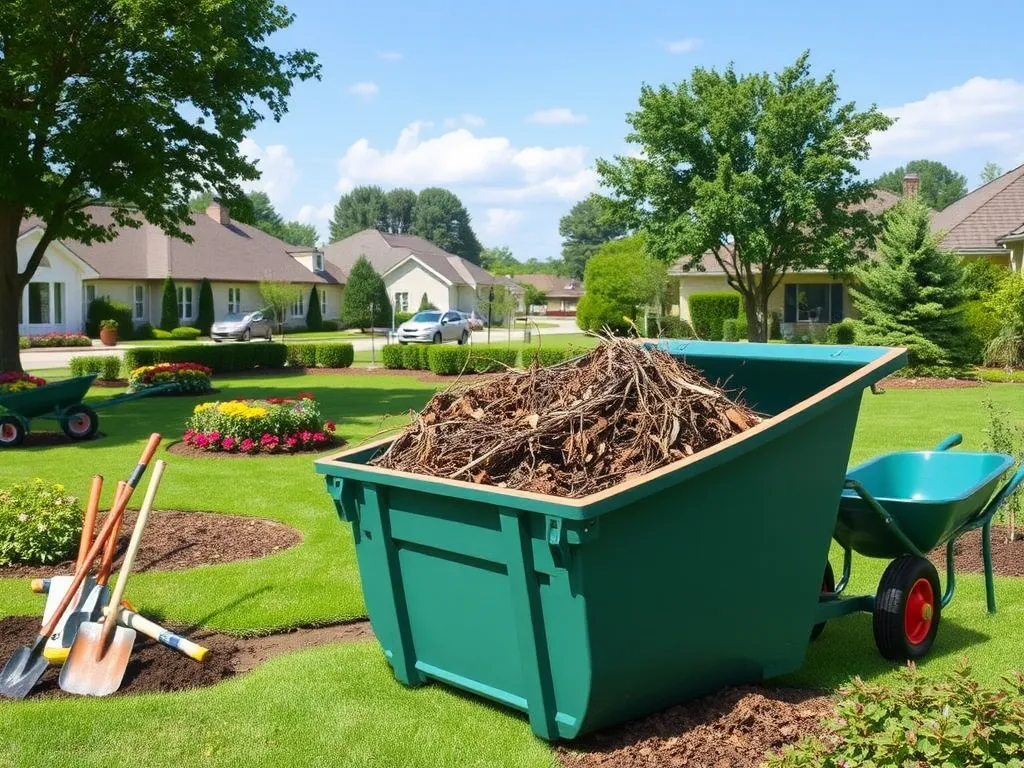Expert Guide on Dumpster Rental for Landscaping Projects

A Comprehensive Guide to Dumpster Rental Landscaping
When embarking on landscaping projects, the necessity for efficient waste management is paramount. Dumpster rental landscaping provides a tailored solution for handling debris and excess materials arising from various landscaping activities, whether it's a simple garden renovation or a major landscape overhaul. Utilizing a dumpster simplifies the disposal process, allowing homeowners and contractors alike to focus on creating beautiful outdoor spaces without the hassle of cleaning up their waste.
In addition to being a practical choice, dumpster rental landscaping plays a critical role in maintaining project timelines and budgets. By offering easy access to waste disposal, it ensures that waste does not pile up on site, potentially slowing down the work. On top of that, many dumpster rental companies offer flexible rental periods, accommodating both short-term and long-term landscaping projects and making it easier for clients to manage their waste disposal needs effectively.
For comprehensive information on the regions we serve and our offerings, visit https://www.torontobinrental.org/service-area.php today.
One of the key advantages of dumpster rental landscaping is the environmental consideration it brings to waste management. By using a dedicated dumpster, landscapers can sort and dispose of waste materials responsibly, which is essential for preserving the environment. Companies are increasingly adopting sustainable practices, ensuring that recyclable materials are processed correctly and reducing the amount of waste sent to landfills. This commitment to eco-friendly disposal methods is vital for responsible landscaping practices.
Moreover, dumpster rental landscaping enhances project efficiency and safety. When landscaping debris is contained within a dumpster, it minimizes the risk of accidents on the job site, creating a safer environment for workers and clients. Furthermore, it allows for a more organized and clutter-free workspace, which can ultimately contribute to better quality workmanship and results in the final landscape design.
In conclusion, dumpster rental landscaping is an effective solution for managing waste during landscaping projects. It offers time-saving benefits, cost-effectiveness, environmental advantages, and promotes job site organization, making it an essential aspect of modern landscaping practices.
Benefits of Dumpster Rental for Landscaping
One of the most significant benefits of using a dumpster for landscaping work is its time-saving waste management solutions. Renting a dumpster means that landscapers can dispose of waste as it accumulates instead of waiting for the project’s conclusion. This helps to keep the project momentum intact and reduces the likelihood of generating delays due to waste accumulation.
Cost-effectiveness is another compelling reason to consider dumpster rental landscaping. Landscaping projects can incur significant costs, so eliminating budget-blowing fees from unexpected waste disposal is essential. Renting a dumpster can streamline disposal costs into one predictable expense, making budgeting easier and preventing overspending on improper waste disposal fees.
The environmental benefits of proper disposal cannot be overstated. When using a dumpster, companies can ensure that recyclable materials like wood, metal, and plastics are diverted from landfills. This practice not only conserves natural resources but also minimizes the overall environmental impact of landscaping work, turning waste management into an eco-conscious endeavor.
Finally, the ease of access to various dumpster sizes allows landscaping professionals to select the perfect fit for their project. Whether it's a small residential garden revamp or a large-scale commercial undertaking, there is a range of dumpster sizes available. This flexibility prevents overloading and ensures efficient waste management throughout the project duration.
Choosing the Right Dumpster Size
To effectively choose the right dumpster size for landscaping projects, it's essential to understand the scope of the project and the volume of waste expected. This includes assessing the types of materials being disposed of and the overall size of the landscape being worked on. By gauging these factors, landscapers can better determine their dumpster needs.
Different landscaping projects can require different dumpster sizes. For instance, a small residential project might only need a 10 or 20-yard dumpster, while larger commercial jobs may necessitate a 30 or 40-yard option. Each size can accommodate varying quantities of vegetation, soil, and construction debris, so evaluating the project size is crucial to determining the appropriate dumpster.
When estimating the right size for a dumpster, users should also consider not only the volume of waste but also its density. Heavier materials like soil and rocks may take up less volume but weigh more, while lighter materials like grass and leaves fill more space without significant weight. Understanding these dynamics can help clients avoid ordering unnecessary larger dumpsters or underestimating their needs.
Common dumpster sizes for landscaping projects typically range from 10 yards to 40 yards. A 10-yard dumpster can handle small yard cleanouts, while 20 to 30-yard dumpsters are perfect for moderate home renovations. For large-scale landscaping or commercial projects, companies typically use a 40-yard dumpster, capable of accommodating significant waste quantities and various debris types.
How to Prepare for Dumpster Delivery
Before the delivery of a rented dumpster, clearing the area for its placement is crucial. This involves ensuring that the location is free from any obstacles like low-hanging branches, garden decorations, or vehicles. A clear path should be created for easy access and delivery by the waste management company.
Moreover, checking local regulations for dumpster placement is vital to avoid any legal pitfalls. Certain municipalities may have specific rules regarding where dumpsters can be placed, such as prohibiting placement on the street without permits or requiring specific signage. Familiarizing oneself with these regulations beforehand can save both time and potential fines.
Planning for easy access and removal of the dumpster should also be a priority. It’s essential to ensure that the location allows for safe and efficient pick-up once the project is completed, considering clearance for the truck and any potential hindrances in surrounding areas.
Finally, avoiding damage to landscaping and property during dumpster delivery is essential. Proper placement can mitigate the risks of damaging gardens, lawns, or hardscapes. It's advisable to put down protective boards or mats to help distribute the weight and prevent damage to underlying areas when the dumpster is dropped off.
Environmental Considerations of Waste Disposal
Recycling landscaping materials responsibly is a fundamental environmental consideration. Many landscaping waste items such as wood and metal can be recycled instead of being disposed of in landfills. Ensuring proper separation of these materials before disposal significantly enhances sustainability efforts in landscaping.
Composting organic waste from landscaping is another excellent practice for minimizing waste impact. Yard waste, such as grass clippings, leaves, and branches, can be composted rather than thrown away, returning nutrients to the soil and benefiting the environment.
Minimizing landfill impact through proper disposal is essential for environmental preservation. By utilizing a dumpster, landscapers can segregate waste streams and prioritize disposal methods that reduce waste sent to landfills, thereby demonstrating ecological responsibility.
Furthermore, understanding local disposal regulations and guidelines ensures compliance and fosters sustainability. Many areas have specific requirements for disposing of certain waste types, and being informed promotes responsible waste management in landscaping, leading to community-based environmental benefits.
Best Practices for Using a Dumpster in Landscaping
Effective loading techniques for space maximization are crucial when using a dumpster for landscaping. Properly loading the dumpster not only maximizes space but also prevents hazards created by overloaded containers or shifting materials during transport.
It's equally important to understand what can and can't be disposed of in a dumpster. Common landscaping waste materials that can be disposed of include leaves, branches, soil, and mulch, while toxic substances like chemicals and treated wood should be handled separately, adhering to local regulations.
Scheduling the pick-up for convenience can help avoid unnecessary delays in ongoing landscaping projects. Knowing when a project is expected to finish allows for timely pick-up arrangements, maintaining efficiency and preventing project downtime.
Lastly, managing multi-phase landscaping projects with dumpsters can enhance organization and efficiency. When working on larger projects, scheduling dumpster rentals phase by phase allows for streamlined waste removal, thereby fostering a smoother transition between project stages.
